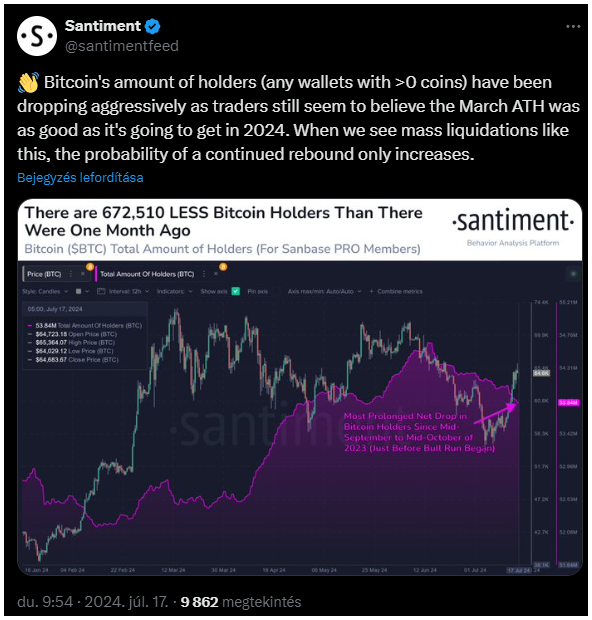Less Bitcoin addresses, but strong ETF inflows and institutional interest in the same time. I guess there is nothing to worry about.
Fewer wallets, bigger chance to jump
On-chain analytics firm Santiment reported a slow decrease in the number of Bitcoin wallet addresses holding BTC over the past month.

The decline, totaling 672,510 addresses, happened as Bitcoin’s price fell from its peak above $70,000 in early June.
The weird part is even with a recent recovery pushing BTC back above $65,000, the number of wallet addresses hasn’t shown a similar rebound.
Yes, the drop in wallet addresses might seem worrying at first, but the historical patterns suggest a recovery. Santiment explained that increases in BTC holder numbers often follow spot market recoveries, but there is a delay, sometimes as long as several weeks.
“When we see mass liquidations like this, the probability of a continued rebound only increases.”
Big dogs are buying
Even when the number of wallet addresses decreased, like now, Bitcoin spot ETFs have seen net inflows for the ninth consecutive day.
On July 17th, these ETFs collectively received more than a hundred million in inflows. BlackRock’s Bitcoin ETF alone saw a net inflow of $110 million, and Fidelity’s Bitcoin ETF received $2.8259 million.
In contrast, Grayscale’s Bitcoin Trust had a net outflow of $53.8612 million on the same day, so the overall balance is close to the 50 million.
While trading volume on centralized crypto exchanges indeed declined for the third month in a row, Bitcoin spot markets have shown signs of recovery, gaining over 10% in the past seven days.
Institutional accumulation is also strong, with large whale wallets, including spot ETFs and custodial wallets, acquiring 1.45 million BTC this year, which is about 9% of the circulating supply.
The weekly inflow to the whales surpassed the total for the entire year of 2021, with 100,000 BTC flowing in each week. Hundred. Thousand. Each. Week.
The first rule of accumulation is you never sell
The percentage of Bitcoin supply in profit dropped to 89.43%, but there are other, more positive metrics.
Ki Young Ju, the founder of the CryptoQuant shared that over-the-counter markets were dominating centralized exchange markets, signaling a clear accumulation trend among institutions.
#Bitcoin OTC markets are overwhelming CEX markets.
Whale wallets (>1K BTC), including spot ETFs and custodial wallets, added 1.45M BTC this year, totaling 1.8M BTC.
In 2021, about 70K BTC flowed in over the year; now, it's 100K BTC "weekly." I repeat. 100K BTC weekly. pic.twitter.com/YJPJpMtMPL
— Ki Young Ju (@ki_young_ju) July 17, 2024
This trend, combined with the decrease in wallet addresses, can be interpreted as good sign, good support for future gains.


